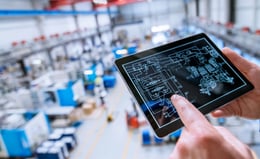5 Advantages of Supply Chain Monitoring
Brian Hoey - November 12, 2020

Let’s say you’re planning to cook a large meal at home later in the week, and you need to get supplies: you have a good sense of what you need for your main dish, and you know what you have in your pantry, but you and your roommate both like to cook, so you don't know exactly how much of your existing inventory will be used up between now and the day you’re cooking. To make matters more complicated, if your roommate is going to cook something, he might use up existing inventory—or he might go to the store himself, potentially resulting in your stores of garlic, onions, and olive oil increasing rather than decreasing in the meantime.
For non-perishable items, this isn’t too big of a deal—but what things like fresh produce that could go bad at a moment’s notice? For these items, it would obviously be preferable to have a heads-up about what’s coming into your pantry in the near future, and which items are already earmarked for particular recipes, otherwise you might spend money on food that gets wasted or get halfway into making paella before realizing you’re out of saffron.
While the scenario—even at its most dire—is likely to seem pretty low-stakes, it’s actually a pretty exact parallel of what happens every day in supply chains around the globe. There, the stakes of effective monitoring aren’t moldy baguettes and rotten tomatoes—but potentially huge accumulations of unnecessary costs.
1. Better Management of Long Supply Chains
Effective supply management—whether that’s in a home kitchen or the automotive supply chain—depends on your ability to gather relevant information about the movements of various materials and goods. The more information you have not just about what’s already in your inventory, but what’s in your suppliers’ inventories on your customers’ wish lists, the more effectively you can master the balancing act between too much costly buffer stock and overly-lean inventories that result in stockouts. This is especially true for supply chains with long tails that might otherwise present difficulties for planners. With a relatively short supply chain, you can probably get enough information to identify bottlenecks just through normal client management tactics—but the more rungs there are on the chain, the more important it is to be able to identify trouble brewing as far upstream as possible.
2. Reduced Stockouts
If the above benefit of supply chain monitoring felt a little abstract, here’s one that’s more concrete: if, through IT integration with your suppliers, you’re able to get a real-time view of the supply situation, you can effectively reduce your risk of stockouts. How? By visualizing your supply needs for various planning horizons and checking those needs with the actual inventory and sourcing realities on an ongoing basis. In a situation with no real-time monitoring of the supply chain, you might rely on static resupply orders for the same quantity of raw materials every month, only to find that uneven demand over a given quarter left you with far too little on hand in some instance and then far too much in others—meaning that on-time orders would be difficult and costly to maintain, but you wouldn’t be getting the cost-reduction benefits of a truly lean supply chain. If, on the other hand, you can visualize what’s supposed to come into the storehouse and what’s supposed to leave the factory floor over the next week, fortnight, or month, you can match supply to demand more effectively, staving off outages before they become problematic.
3. Reduced Buffer Stock
Now, as you’re monitoring your supply chain via integrated IT solutions, IoT devices, sensors, and other means—and then turning those monitoring activities into smarter, more proactive planning and management—you might begin to notice something: that your buffer stock needs to be utilized much less frequently than before. That’s not by accident. On the contrary, the more effectively you’re able to understand what’s happening across touch-points in real-time, the less frequently you’ll find that the need for a particular part or material takes you by surprise. As you’re able to reduce the frequency with which the unexpected occurs, you can make your whole supply chain leaner in a measured, considered way—starting with your buffer stock. Real-time monitoring puts you in a position to reduce buffer stock without increasing risk, and thus decrease your capital commitments on an ongoing basis.
4. Better Bottleneck Avoidance
If we’re starting to sound like a broken record, that’s because the benefits of supply chain monitoring are pretty apparent once you start thinking about them. Case in point, in just the same way you can visualize your supply chain planning needs relative to your inventory and sourcing workflows in order to reduce stockouts, you can do the same to identify and prevent bottlenecks far enough in advance to maintain on-time deliveries and keep costs down. The crucial difference here is that in addition to showing supply utilization in real-time for your production flows, your solution can also offer insight into the factors at work across your entire network, offering you a proactive means of identifying potential issues and automatically comparing multiple planning scenarios on an ongoing basis. In this way, you avoid disruptions while also promoting transparency.
5. Improved Real-Time Planning
Speaking of transparency: one of the most powerful effects of the kind of monitoring we’ve been discussing is that it doesn’t just take in information—it makes that information visually legible and accessible across multiple touchpoints. This means that from a planning perspective, you don’t just have a mass of disorganized information. Instead, you have projections, comparisons, ranges of coverage, and more at your fingertips. Why does this matter? Because it means that you can actually leverage real-time information into real-time adaptability in your plans and schedules. When a supply chain alert goes off, you can immediately visualize the value chain impacts of different potential decisions (auto-generated by your monitoring solution’s analytics engine), select the optimal one, and then immediately let planners at other touchpoints know what the new plan is so that they can set their expectations accordingly. In this way, you get faster and smarter with your in-the-moment decisions, leaving you with fewer delays that result in costly premium freight.
If you want to learn more get your Guide to Multi Dimension Monitoring
In this Guide you will learn:
- The Advantages of Multi Dimension Monitoring
- Perspectives from a production or a transport point of view
- Potentials for Planners and Dispatchers
LATEST POSTS
- Understand Circular Economy in The Manufacturing Industry
- How Can Industry 4.0 IT Integration Be Achieved Smoothly?
- The Significance of Order Sequencing in Discrete Manufacturing
- How to improve your Supply Chain Management: The Power of Control Towers
- Optimizing Human Resource Scheduling in Manufacturing: A Technological Approach



